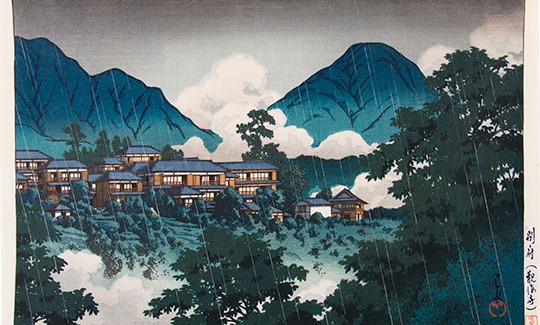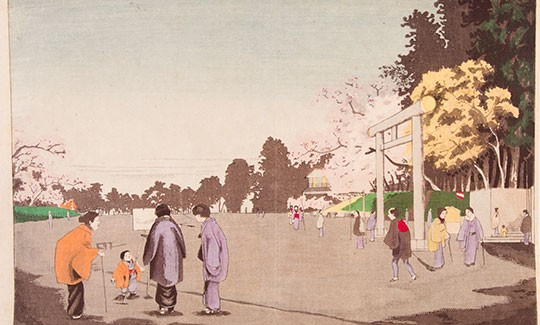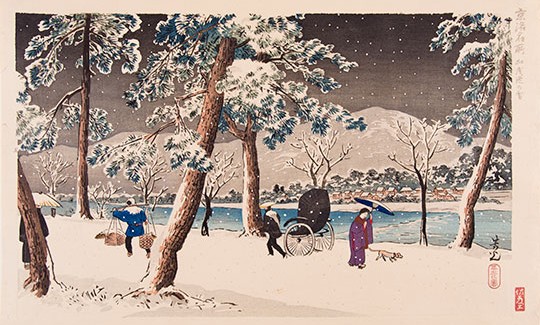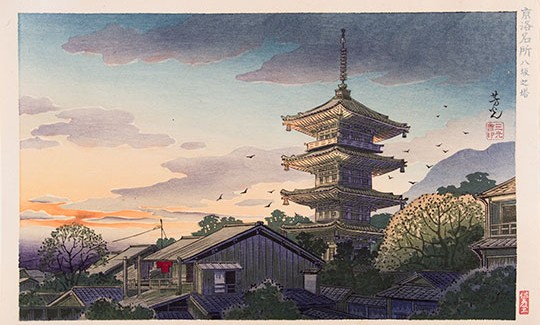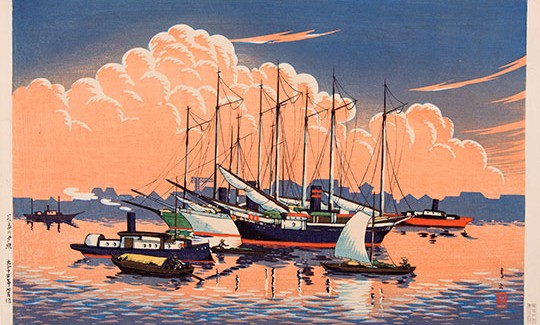Shin-hanga
The New Prints
Most of the Japanese artists in the latter half of the 19th century were pupils of Utagawa Kuniyoshi, Utagawa Kunisada, and Utagawa Hiroshige. However, in contrast to their masters of traditional print, who used lyrical colours,, the younger artists preferred brighter colours and dominant shades such as red or purple. This new and heightened use of colour was seen by their contemporaries as resulting from Western influence. However, after a short phase in which Japan was flooded with such prints, some Japanese artists began to seek an artistic compromise between traditional and Western-influenced art. What resulted was an artistic movement called shin-hanga (New Prints), active mainly in the first thirty years of the 20th century.
Traditional ukiyo-e prints (ukiyo-e: pictures from the Floating World) were among the most important artistic achievements of the Edo era (1603-1868), whose decline began with the death of the artist Ando Hiroshige in 1858. Two contributing factors to this change were the opening of the gates of Japan to the West in 1853 and the Meiji Restoration (1868) which led, among other things, to the discovery of new artistic works. At this time, Japan was greatly exposed to the influence of European art, although there were those who recognized the need to preserve their traditional art.
Most of the artists in the latter half of the 19th century were pupils of Utagawa Kuniyoshi, Utagawa Kunisada, and Ando Hiroshige, though the younger artists differed from their predecessors in their use of colour, preferring brighter colours and dominant shades, such as red or purple. This riot of colour was in total contradiction to the lyricism of the traditional works of the print artists, and these innovators were perceived accordingly by their contemporaries as ‘westernized’ in style. After a short phase in which Japan was flooded with such prints, some Japanese artists, among them Kobayashi Kiyochika (1847-1915), Nomura Yoshimitsu (1870-1958), Kawase Hasui (1883-1957), Ohara Koson (1887-1945) and Miki Suizan (1887-1957) began to seek an artistic compromise between traditional and western-influenced art. What resulted was an artistic movement called shin-hanga (New Prints), active mainly in the first thirty years of the 20th century.
Kawase Hasui, encouraged by the publisher Watanabe Shuzaburo, was one of the best-known traditionalist artists who tried to revive this art while at the same time develop the trend towards realism which had already begun to appear at the end of the 18th century. Indeed it is apparent in his works from the beginning of the 20th century that he succeeded in integrating in his prints the foundations of the innovative, European aesthetic of his time.
Kawase Hasui created some 416 prints during his lifetime, most of which were published by Watanabe Shuzaburo. Unfortunately, in fires which broke out in 1923 following the earthquake which destroyed Tokyo, all the wooden blocks of his prints were lost. Thus all the prints which are stamped with a round seal enclosing three drops of water (sui) were printed by Hasui after the earthquake. In 1956, Kawase Hasui received the title ‘Living National Treasure’, as one who had preserved the art of the traditional woodblock print.
The integration of new, western concepts such as perspective and realism arose from the desire to salvage the moribund art of printing. Realistic representation or photographic depiction of the landscape in the western sense constituted something new for Japan. Indeed, the artists endeavoured to create such illusions as snow, or realistic watery reflection in a river or a lake. Thus these prints mark the passage of the Japanese print from the traditional to the modern. Nonetheless, the prints were produced by the traditional method – the artist drew the picture, the carver prepared the block and the printer printed the work, which was then marketed by a professional publisher.
Shin-hanga works, which were mainly sold to foreigners, succeeded not just in preserving the art of the ukiyo-e, but even in surpassing it, both technically and artistically. Still this eager adoption of a new culture struck a blow at the traditional art, somewhat depleting it of its spirit and values in the attempt to replicate nature in the pursuit of absolute realism.
Ironically, while European artists were seeking ways to escape their artistic tradition of realism by turning to the Japanese print, Japanese artists were being influenced by western realism and perspective - those very techniques which western artists had abandoned. Undoubtedly, this marked the end of the traditional art of the Japanese print.
Curator: Dr. Ilana Singer Blaine

